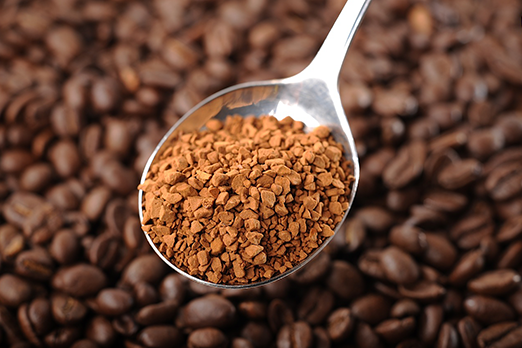Another Cup Of Instant Coffee

Humourist and columnist for the Parisian newspaper, Le Chat Noir, Alphonse Allais, is credited with developing the first water-dissolving instant coffee granules, inspired by his comrades’ complaints about the quality of coffee while on national service. Although he was awarded a patent in 1881, (no. 141530), the text is indecipherable, leading some to suggest that it was one of his leg-pulls. After all, he had patented a frosted glass aquarium for shy fish.
David Strang who owned the Coffee and Spice Works in Invercargill on New Zealand’s South Island has stronger claims. In 1889 he developed and patented “Strang’s Soluble Dry Coffee-powder”, made by blowing hot air over freshly brewed coffee until it evaporated into a powder, much like the way he dried his spices.
Packed in a tin, light, stable, and with a long shelf life, it was the first commercially viable instant coffee, marketed as a drink of convenience. One of Strang’s adverts claimed that it was “the most enjoyable drink you can have at Picnics, Camps and Out of Doors…made in a minute, milk and sugar to taste. Far superior to any so-called coffee essence”.
Having cut his teeth on soluble tea, Chicago-based chemist Satori Kato developed a method for separating the volatile oils from coffee and then recombining them with the dried product, a method which retained much of the flavour and extended its shelf life. He exhibited his product at the Pan-American Expo in 1901.
However, these early examples of instant coffee were niche products until Belgian-American serial inventor, George Washington, came on to the scene. After noticing some dried coffee on the spout of his coffee pot, he developed a secret process, never patented, which, as an advertisement in the New York Times in 1914 revealed, “removes the disturbing acids and oils (always present in ordinary coffee)”, allowing consumers to “drink all the coffee you wish” without running the risk of indigestion.
Washington launched Red E Coffee in 1909, rebranded as George Washington’s Prepared Coffee the following year, which he mass-produced and advertised with gusto. Although the taste was mediocre at best, Washington had established such a market position by the time the Americans entered the First World War in 1917 that he was asked to satisfy the troops’ coffee requirements.
His factory swung into action, producing a serving of three-quarters of an ounce of instant coffee granules in an envelope, twenty-four to a can. At its height, he was producing 40,000 lbs of coffee a day. On the front line, soldiers would tip the contents of an envelope into a tin mug, stirring in hot water. Their “cup of George” was one of the few creature comforts around, so valued that one soldier was moved to write home vowing that “there is one gentleman I am going to look up first after I get through helping whip the Kaiser, and that is George Washington of Brooklyn, the soldier’s friend”.
Nestlé’s Nescafe, launched in 1938, is the UK’s most popular instant coffee, with around 13.7 million Brits using it. It soon established a reputation for being superior to other products around, tastier, more flavoursome, and with a more appealing aroma, one it has retained to this day.
What would John Dring have made of it all?



